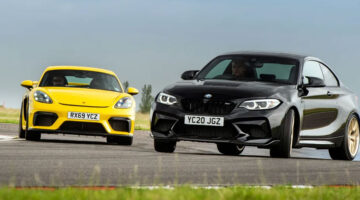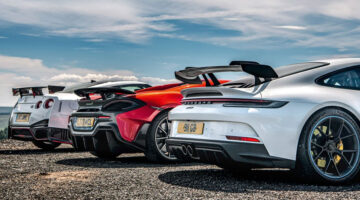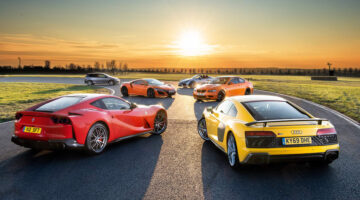It may be more than 50 years old, but Porsche’s RS ‘Rennsport’ division remains among the most respected in the motoring world today. We pit the latest up against the arguably greatest
| Porsche | Engine | Power | Torque | 0-100kph | Top speed | Weight | Value today |
|---|---|---|---|---|---|---|---|
| Carrera RS 2.7 (1973) | Flat-six, 2,687cc | 210bhp @ 6300rpm | 188lb ft @ 5100rpm | 5.2sec | 245kph | 1093kg (192.13bhp/ton) | $600K-$900K |
| 911 GT3 RS | Flat-six, 3,996cc | 493bhp @ 8,250rpm | 339lb ft @ 6,250rpm | 3.3sec | 310kph | 1420kg (347bhp/ton) | $167,900 |
We don’t say it aloud, but both crankandpiston cohort Bassam and I know this is going to be a special day. Several times already, the early morning rays have twanged off the lightweight body panels of the 2015 Porsche 911 GT3 RS and 1973 Porsche Carrera RS 2.7 stands at a tangent to us, facing in the opposite direction as if on a drag strip. In our peripheral vision, crankandpiston.com photographer Hari is collecting the third of an eventual two dozen ‘money shots’ while the light is working in our favour, and only once that is done can Bassam and I crane in for a closer inspection. There’s plenty to mull in the meantime, mind you. Between the two RS Porsches sit a 43-year heritage of arguably the most respected performance division in the automotive world (the former is practically a godfather). Collectively, they’re valued just shy of $1 million, $750K of which is courtesy of the ’73 2.7 alone. Combined power is an impressive 705bhp, and neither model – despite one being close to half a century old – are barely out of breath at 230kph. And today, as part of an exclusive regional feature for crankandpiston.com, we get to drive both of them.
Like I say, it hardly seems necessary voicing aloud the magnitude of this occasion.
I’m struck, as I shift my weight impatiently from one foot to the next, by the sheer difference in size between the Rennsport pair, and the natural progression of development that’s gradually led us from one to the other. Bassam seems to be on my wavelength, motioning towards the sub-1000kg 2.7 and mentioning that he “could probably place it under his arm, and walk away with it.” Whether Assyl Yacine, Head of the Classic Car Division at Tomini Classics and custodian of the 2.7 RS here today, will allow him remains to be seen.
I take his point though, and again, I consider the difference in girth. Like the Turbo, the rear track on the 2015 GT3 RS is wider to improve mid-corner traction, the Michelin Pilot Sport Cups that fit snuggly over the 21in alloys and beneath those flared wheel arches the widest tyres ever to be fitted to a production 911. Intakes cluster around the aggressive diffuser – much as they do around the jutting front splitter at the other end – to draw air to the highest displacement flat-six ever used in the 911. And on top of that, a massive fixed rear spoiler offers 80 per cent of the downforce provided by the GT3 R racer. It’s positively awe-inspiring in its aggression.
By comparison the 2.7 is almost comically unfussy. The rear wheel arches are no more muscular than the front, all the better for highlighting the two-tone Grand Prix White and red Fuchs alloys and 15in all-weather tyres. There’s no penetrating rear diffuser as found on the GT3, nor ‘muscular’ rear bumper. Even the single steel exhaust tip feels understated. Instead, there’s ‘just’ the iconic ducktail, borrowed from Porsche’s race team of the time to improve the 911’s often-tricky high speed cornering characteristics. By modern standards, it’s rudimentary. And yet it’s probably the biggest reason why the 2.7 RS design remains the most replicated in Porsche history.
“The magnitude of pairing the 2.7 RS and the GT3 lies almost tangibly in the air”
By 1972, Porsche’s racing life with the 917 was done, new regulations for the World Sportscar Championship – focusing on smaller engine displacements – ensuring that the 917, Ferrari 330 P4 and others of its volcanic ilk were redundant overnight. Not so the brand new Group 5 Sports Car class, and rather than building a new car from scratch, Porsche instead set about converting its still relatively new 911 for Group 5 competition. Fibreglass and ultra thin gauge steel body panels around the now widened rear wheels dropped weight significantly, while a larger displacement 2.7-litre flat-six – 346cc larger than the 911 S 2.4 Coupe from which it was sourced – was belted down over the rear axle for 210bhp and 202lb ft-worth of grunt. Success arrived quickly, the race-spec 911 RSR taking victory on its debut at the 24 Hours of Daytona, 22 laps ahead of second-placed Ferrari.
On-track success came at a price though, specifically the 500 road-going homologated models Porsche would have to produce before a lightweight wheel could be turned in anger. The end result – the 2.7 RS – made its debut at the 1972 Paris Motor Show. By week’s end, and with customer interest duly peaked by this legitimate ‘race car for the road’, all 500 models had been sold. A further 500 fell just as quickly, and in total, close to 1600 were manufactured (official figures vary between 1540 and 1580). A follow-up RS would take 18 years to appear, but there was no doubt, Porsche’s RS legacy had leapt from the blocks.
Fast-forward four decades to the 991 GT3 RS – the fifth road-going Rennsport – and developments in both road-car and track technology mean the disparity to Porsche’s race cars is closer than ever. Weight saving was again a priority, with carbon fibre bonnet and wings, a magnesium roof and polycarbonate rear windows fitted as standard and the floor matts and ‘weighty’ door handles also being given the boot (even the Porsche badge on the bonnet has been ditched for a sticker). Power has increased from 470bhp to 495bhp over the performance-focused 911 GT3 base model, torque doing likewise from 325lb ft to 339lb ft. The GT3 may pip the RS’s top speed – 315kph versus 311kph – but Rennsport tinkering to the suspension and chassis, plus the addition of further bracing, makes Porsche’s closest example yet to a road-going race-car considerably more manoeuvrable (it’s Nürburgring lap-time was EIGHT seconds faster than the GT3). Once again, a limited production run didn’t take long to sell out, the RS lineage secured for another generation. Once again, the magnitude of pairing both the forefather and its 21st century equivalent for one day only lies almost tangibly in the air.
In a foolish fit of enormous generosity, Shahid Baloch – Vice President of Porsche Club UAE – has generously left his GT3 RS with crankandpiston.com while he goes to work. No finger waving, no speed or mileage limits, no cursory comments regarding the traction control. “Drive it hard, you’ll be amazed what it can do.” Top bloke.
Mercifully, Hari clicks the shutter on his Canon for the final time, flashing the thumbs up ‘all clear’ and signalling that his work is done for the day.
Game time. This is going to be awesome.
Story continues on page 2





